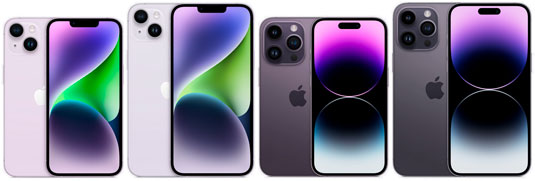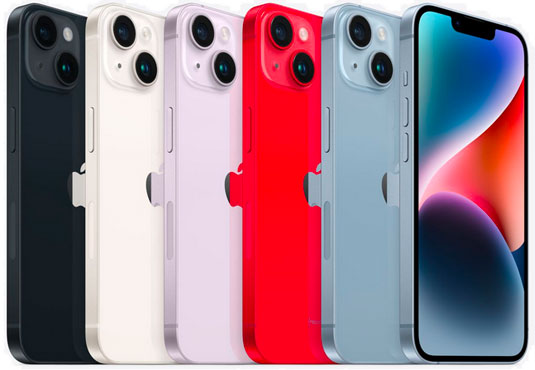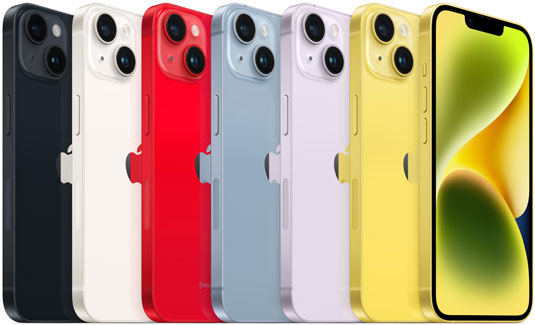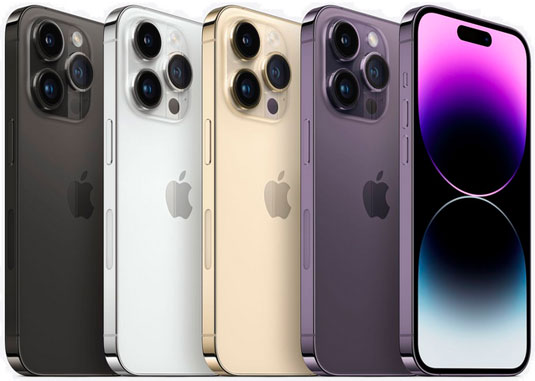Hosted by site sponsor WebMate.
iPhone Q&A
Update Published September 24, 2025
All Apple Q&As >> iPhone Q&A (Home)
To be notified of new Q&As, sign up for EveryMac.com's bimonthly email list.
What are the major differences between the iPhone 14/iPhone 14 Plus and iPhone 14 Pro/iPhone 14 Pro Max? Which is best for my needs?
Note that the iPhone 14, iPhone 14 Plus, iPhone 14 Pro, and iPhone 14 Pro Max all have been discontinued. This Q&A has been updated subsequently and can be quite useful to anyone considering one of these models on the used market.
There are twenty different iPhone 14, iPhone 14 Plus, iPhone 14 Pro, and iPhone 14 Pro Max models (five of each), but this Everyi.com Q&A primarily covers the collective differences to make it simple to choose which is ideal for you.

Photo Credit: Apple, Inc. (Left to Right: iPhone 14, 14 Plus, 14 Pro, 14 Pro Max)
These four iPhone models released in 2022 have quite a bit in common. However, there are some significant differences, as well. The similarities can be worthwhile to understand, too.
External Design & Functionality Differences
The iPhone 14, iPhone 14 Plus, iPhone 14 Pro, and iPhone 14 Pro Max models look nearly identical -- rounded rectangles with flat sides, a glass front and back, and nearly edge-to-edge displays.
However, the entry-level iPhone 14 and iPhone 14 Plus have the now familiar "notch" at the top to hold cameras and sensors whereas the higher-end iPhone 14 Pro and iPhone 14 Pro Max unveiled a clever new "Dynamic Island" toward the top of the display. This "Dynamic Island" essentially is two holes in the display for cameras and sensors, but it is merged together via software by making a portion of the display black. This island cannot disappear entirely or "shrink" to be smaller than its default size, but in software, it can appear to "grow" as needed to show relevant activities and notifications. Slick.
The two entry-level iPhone 14 and iPhone 14 Plus models use a case that is primarily aluminum whereas the higher-end iPhone 14 Pro and iPhone 14 Pro Max use a mostly stainless steel case. The iPhone 14 Pro and iPhone 14 Pro Max also have nicely textured glass with a matte finish that is a bit easier to grip than the entry-level models.
All of these models have a "Ceramic shield" on the front side for durability and are waterproof to the IP68 standard (IEC standard 60529) for up to 30 minutes of water exposure to a depth of six meters.
Each of these devices also have stereo speakers, a Lightning connector, magnetic "MagSafe" charging capability, and support for "wireless" charging. Models sold outside of the United States also have a side-mounted access panel for physical SIM access.
The iPhone 14 and iPhone 14 Pro are smaller than the iPhone 14 Plus and iPhone 14 Pro Max. The "Pro" models are a bit heavier, as well:
 14 |
 14 Plus |
 14 Pro |
 14 Pro Max |
|
| Material: | Aluminum/Glass | Aluminum/Glass | Steel/Glass | Steel/Glass |
| Height (In.): | 5.78 | 6.33 | 5.81 | 6.33 |
| Width (In.): | 2.82 | 3.07 | 2.81 | 3.05 |
| Depth (In.): | 0.31 | 0.31 | 0.31 | 0.31 |
| Weight (Oz.): | 6.07 | 7.16 | 7.27 | 8.47 |
Display Differences
The screens in the iPhone 14, iPhone 14 Plus, iPhone 14 Pro, and iPhone 14 Pro Max are all high-quality.
However, in addition to including the "Dynamic Island" functionality, the iPhone 14 Pro and iPhone 14 Pro Max models have displays that are even better quality than the two entry-level options.
Specifically, the iPhone 14 Pro and iPhone 14 Pro Max models have "Super Retina XDR with ProMotion" displays which are brighter and support an adaptive refresh rate from 1 Hz to 120 Hz for faster frame rates and more comfortable viewing when scrolling:
 14 |
 14 Plus |
 14 Pro |
 14 Pro Max |
|
| Display Type: | XDR | XDR | ProMotion | ProMotion |
| Dimensions: | 6.1" | 6.7" | 6.1" | 6.7" |
| Resolution: | 2532x1170 | 2778x1284 | 2556x1179 | 2796x1290 |
| PPI: | 460 | 458 | 460 | 460 |
| Brightness: | 800 nits | 800 nits | 1000 nits | 1000 nits |
| HDR Max: | 1200 nits | 1200 nits | 1600 nits | 1600 nits |
| Contrast: | 2 million:1 | 2 million:1 | 2 million:1 | 2 million:1 |
| Always On: | No | No | Yes | Yes |
Also note that the iPhone 14 Plus has fewer pixels per inch than the other three models.
Housing Color Differences
In addition to material differences, there are color differences between the entry-level iPhone 14 and iPhone 14 Plus and the higher-end iPhone 14 Pro and iPhone 14 Pro Max.

Photo Credit: Apple, Inc. (iPhone 14/iPhone 14 Plus Original Colors)
The iPhone 14 and iPhone 14 Plus (above) originally were offered in five colors (left to right): "Midnight" (black), "Starlight" (warm gray), (pale) Purple, (PRODUCT) RED, and (pale) Blue.
On March 7, 2023, Apple added a sixth color -- Yellow -- to the mix.

Photo Credit: Apple, Inc. (iPhone 14/iPhone 14 Plus 2023 Colors)
The iPhone 14 Pro and iPhone 14 Pro Max shipped in four color options (left to right): "Space Black," Silver, Gold, and dark "Deep Purple."

Photo Credit: Apple, Inc. (iPhone 14 Pro/iPhone 14 Pro Max Colors)
In 2023, Apple kept the colors the same for the iPhone 14 Pro/iPhone 14 Pro Max.
Along with texture, material, and weight, Apple continued to use color to make the "Pro" models feel more premium than the entry-level iPhone 14 and iPhone 14 Plus, as well.
Camera Differences
For most users, the cameras in the entry-level iPhone 14 and iPhone 14 Plus and the higher-end iPhone 14 Pro and iPhone 14 Pro Max are the most important difference.
The front cameras have the same capabilities, but the iPhone 14 Pro and iPhone 14 Pro Max support ProRAW photography and ProRes video recording. The rear cameras in the iPhone 14 Pro and iPhone 14 Pro Max are significantly more capable, as well.
Front Cameras
The front-facing camera on all four of these models -- which Apple has dubbed "TrueDepth" -- support "Face ID" authentication, augmented reality (AR), still photos, and 4K video recording:
 14 |
 14 Plus |
 14 Pro |
 14 Pro Max |
|
| Megapixels: | 12 MP | 12 MP | 12 MP | 12 MP |
| Aperture: | f/1.9 | f/1.9 | f/1.9 | f/1.9 |
| Video: | 4K | 4K | 4K* | 4K* |
| ProRAW: | No | No | Yes | Yes |
| ProRes: | No | No | Yes* | Yes* |
*The iPhone 14 Pro and iPhone 14 Pro Max with 128 GB of storage only support the ProRes codec at 1080p at 30 fps. Higher capacity models (256 GB, 512 GB, 1 TB) support ProRes up to 4K.
Rear Cameras
The iPhone 14 and iPhone 14 Plus rear cameras have dual 12 megapixel "Main" and "Ultra Wide" lenses that shoot still photos and 4K video with a variety of filters and processing options.
The iPhone 14 Pro and iPhone 14 Pro Max models are even better and have rear triple lens camera systems in addition to support for the Apple ProRAW photo format and ProRes video codec for more flexible and professional editing options:
 14 |
 14 Plus |
 14 Pro |
 14 Pro Max |
|
| Megapixels: | 12/12 MP | 12/12 MP | 48/12/12 MP | 48/12/12 MP |
| Main: | f/1.5 | f/1.5 | f/1.78 | f/1.78 |
| Ultrawide: | f/2.4 | f/2.4 | f/2.2 | f/2.2 |
| Telephoto: | No | No | f/2.8 | f/2.8 |
| SS OIS: | Main | Main | Dual | Dual |
| Macro Support: | No | No | Yes | Yes |
| Digital Zoom: | 2x-5x* | 2x-5x* | 2x-15x* | 2x-15x* |
| Apple ProRAW: | No | No | Yes | Yes |
| Apple ProRes: | No | No | Yes | Yes |
* By combining an image from multiple cameras, these models emulate a 2x optical zoom and provide an enhanced digital zoom (up to 5x for the iPhone 14 and iPhone 14 Plus; up to 15x for the iPhone 14 Pro and iPhone 14 Pro Max).
Identification Differences
At the time these models first were introduced, the iPhone 14 Pro and iPhone 14 Pro Max models could be spotted easily by the "Dynamic Island" but this is not worthwhile for long-term identification because this feature is shared by some subsequent models. The iPhone 14 and iPhone 14 Plus models also are easy to mix up with earlier and later models.
Furthermore, it is not possible to identify specific models within each line by appearance alone, either.
One relatively easy way to uniquely identify these models is by the Model Number listed on the cardboard shipping box and within the iOS "Settings" app.
Consequently, for the purpose of this Q&A, it is sufficient to note that the following model numbers refer to these iPhone devices:
iPhone Model |
Model Number |
EveryiPhone.com's Ultimate iLookup feature also can precisely identify these iPhone models by Order Number (referred to as "Model" within the iOS "Settings" app under General > About), and other identifiers, as well.
Battery Life Differences
The iPhone 14, iPhone 14 Plus, iPhone 14 Pro, and iPhone 14 Pro Max all have impressive battery life:
 14 |
 14 Plus |
 14 Pro |
 14 Pro Max |
|
| Local Video: | 20 Hours | 26 Hours | 23 Hours | 29 Hours |
| Streaming: | 16 Hours | 20 Hours | 20 Hours | 25 Hours |
| Audio: | 80 Hours | 100 Hours | 75 Hours | 95 Hours |
Interestingly, the high-end iPhone 14 Pro Max provides the longest runtime in video tasks, but the lower-end iPhone 14 Plus actually provides the longest runtime for audio.
All of these devices are capable of charging to 50% capacity in 30 or 35 minutes, also.
Wireless Connectivity & Data Differences
Collectively, the iPhone 14, iPhone 14 Plus, iPhone 14 Pro, and iPhone 14 Pro Max models each provide much of the same connectivity. For example, all provide 5G support, Gigabit LTE with 4x4 MIMO and LAA, Wi-Fi 6 (802.11ax) with 2x2 MIMO, Bluetooth 5.3, Ultra Wideband "for spatial awareness," NFC capability, and more.
However, there are a few 5G and 4G LTE bands that are supported by some models and not others. Specifically, for 5G, models sold in the United States support 5G mmWave bands n258 (26 GHz), n260 (39 GHz), n261 (28 GHz), but others do not. Models sold in Canada, Mexico, Japan, and Saudi Arabia support the 5G bands n14 (700 PS), n29 (700d MHz), n53 (TD 2500), and n71 (600 MHz). Models sold in other countries do not support these bands.
Supported 4G and 5G bands vary accordingly:
iPhone Model |
Model No |
Additional 4G/5G |
iPhone 14 (US) |
14 (700 PS) n14 (700 PS) n258 (26 GHz) |
|
iPhone 14 (CA/MX/JP/SA) |
11 (1500 MHz) n14 (700 PS) |
|
iPhone 14 (Global) |
No Differences |
|
iPhone 14 (China) |
No Differences |
|
iPhone 14 (Russia) |
No Differences |
All models support at least dual SIMs, but specifics vary. Models sold in the United States support dual eSIMs and models sold in China support dual physical Nano SIM. Models sold just about everywhere else have dual eSIMs and a single physical Nano SIM.
Internal Differences
The entry-level iPhone 14 and iPhone 14 Plus use an earlier architecture than the higher-end iPhone 14 Pro and iPhone 14 Pro Max. The "Pro" models also have the option of more storage and add LiDAR support:
 14 |
 14 Plus |
 14 Pro |
 14 Pro Max |
|
| Clockspeed: | 3.2 GHz | 3.2 GHz | 3.5 GHz | 3.5 GHz |
| Processor: | A15 | A15 | A16 | A16 |
| CPU: | 6 Cores | 6 Cores | 6 Cores | 6 Cores |
| GPU: | 5 Cores | 5 Cores | 5 Cores | 5 Cores |
| RAM: | 6 GB | 6 GB | 6 GB | 6 GB |
| Storage: | 128/256/512 | 128/256/512 | 128/256/512/1 | 128/256/512/1 |
| LiDAR: | No | No | Yes | Yes |
From a performance standpoint, the higher-end iPhone 14 Pro and iPhone 14 Pro Max are in the neighborhood of 9% to 19% faster than the entry-level models.
iOS Support Similarities
The iPhone 14, iPhone 14 Plus, iPhone 14 Pro, and iPhone 14 Pro Max all originally shipped with iOS 16. They also all support iOS 17, iOS 18, and iOS 26, the current version of the iOS, but feature support is slightly different.
Running iOS 17, the iPhone 14 and iPhone 14 Plus do not support the minor Point and Speak accessibility functionality, wheras the iPhone 14 Pro and iPhone 14 Pro Max do support Point and Speak.
Running iOS 18 and iOS 26, none of these models support the Apple Intelligence (AI) feature, but otherwise fully support these operating systems.
iPhone 14, 14 Plus, 14 Pro & 14 Pro Max Comparison Chart
These differences as well as other details and pricing information is summarized below:
 14 |
 14 Plus |
 14 Pro |
 14 Pro Max |
|
| Introduced: | Sep 2022 | Sep 2022 | Sep 2022 | Sep 2022 |
| Discontinued: | Feb 2025 | Feb 2025 | Sep 2023 | Sep 2023 |
| Processor: | A15 | A15 | A16 | A16 |
| RAM: | 6 GB | 6 GB | 6 GB | 6 GB |
| Storage: | 128/256/512 | 128/256/512 | 128/256/512/1 | 128/256/512/1 |
| Battery Life: | 16-80 Hours | 20-100 Hours | 20-75 Hours | 25-95 Hours |
| Display Size: | 6.1" | 6.7" | 6.1" | 6.7" |
| Display Type: | XDR | XDR | ProMotion | ProMotion |
| Resolution: | 2532x1170 | 2778x1284 | 2556x1179 | 2796x1290 |
| PPI: | 460 | 459 | 460 | 460 |
| Brightness: | 800 nits | 800 nits | 1000 nits | 1000 nits |
| Front Camera: | 12 MP | 12 MP | 12 MP | 12 MP |
| Rear Camera: | 12/12 MP | 12/12 MP | 48/12/12 MP | 48/12/12 MP |
| Material: | Al/Glass | Al/Glass | Steel/Glass | Steel/Glass |
| Colors: | 6 Colors | 6 Colors | 4 Subdued | 4 Subdued |
| SIM Card: | Nano/eSIM | Nano/eSIM | Nano/eSIM | Nano/eSIM |
| 5G: | Yes | Yes | Yes | Yes |
| MagSafe: | Yes | Yes | Yes | Yes |
| Orig. iOS: | iOS 16 | iOS 16 | iOS 16 | iOS 16 |
| Max. iOS: | iOS 26 | iOS 26 | iOS 26 | iOS 26 |
| Orig. USD: | US$799 US$899 US$1099 |
US$899 US$999 US$1199 |
US$999 US$1099 US$1299 US$1499 |
US$1099 US$1199 US$1399 US$1599 |
| Orig. GBP: | £849 £959 £1179 |
£949 £1059 £1279 |
£1099 £1209 £1429 £1649 |
£1199 £1309 £1529 £1749 |
| Orig. CAD: | C$1099 C$1249 C$1519 |
C$1249 C$1399 C$1669 |
C$1399 C$1549 C$1819 C$2089 |
C$1549 C$1699 C$1969 C$2239 |
| Orig. AUD: | A$1399 A$1579 A$1899 |
A$1579 A$1749 A$2099 |
A$1749 A$1899 A$2249 A$2599 |
A$1899 A$2099 A$2419 A$2769 |
| Orig. JPY: | ¥119,800 ¥134,800 ¥164,800 |
¥134,800 ¥149,800 ¥179,800 |
¥149,800 ¥164,800 ¥194,800 ¥224,800 |
¥164,800 ¥179,800 ¥209,800 ¥239,800 |
| Orig. CNY: | RMB 5,999 RMB 6,899 RMB 8,699 |
RMB 6,999 RMB 7,899 RMB 9,699 |
RMB 7,999 RMB 8,899 RMB 10,699 RMB 12,499 |
RMB 8,999 RMB 9,899 RMB 11,699 RMB 13,499 |
These original prices are for devices unlocked and paid in full upfront. Carrier subsidized options, leases, and trade-in discounts also were available. On September 12, 2023, Apple cut the price of the iPhone 14 and iPhone 14 Plus models by US$100 each; cut the prices again by US$100 each on September 9, 2024; and discontinued these models entirely on February 19, 2025.
For pricing in dozens of countries, see the "Global Prices" on the specs page for each iPhone as well as the "By Global Original Prices" section of EveryiPhone.com.
So, which is for me? Should I buy an iPhone 14, iPhone 14 Plus, iPhone 14 Pro, or iPhone 14 Pro Max?
Although the pace of improvement clearly has slowed in recent years, the Phone 14, iPhone 14 Plus, iPhone 14 Pro, and iPhone 14 Pro Max still were quite impressive, albeit expensive, when they were first released. On the used market, the prices have declined, but the decision between these models remains mostly the same (ignoring subsequent iPhone models, naturally).
In many respects, the first decision to make is whether you want a relatively small iPhone or a huge one. If you want the smallest recent-ish iPhone possible, you may prefer to instead get an older iPhone 13 mini, but just for the iPhone 14 line, the iPhone 14 and iPhone 14 Pro are the smaller options and the iPhone 14 Plus and iPhone 14 Pro Max are the huge options.
The second decision to make is whether or not the "Pro" model of either size is worth the extra money to you (originally an extra US$200 for each). This extra money buys (1) a stronger steel frame and textured glass for easier grip, (2) a significantly higher quality display, (3) a much more advanced rear camera with support for a more professional file format and video codec, (4) the clever "Dynamic Island" feature, (5) a bit more performance, and (6) and LiDAR support. At additional cost, you also have (7) the option of more storage.
For many users, the "Pro" camera alone is worth the extra money, but for those on a budget, the entry-level iPhone 14 or iPhone 14 Plus should be more than adequate. Naturally, any number of other used iPhone models are well worth considering to save even more money, too.
In the US, site sponsor Other World Computing sell used and refurbished iPhone models also with free shipping. On the other hand, if you need to sell an iPhone, A+ BBB-rated Cash for Your Mac and GoRoostr will buy your older iPhone with an instant quote and prompt payment.
Please also see EveryiPhone.com's Ultimate iComparison feature to dynamically compare any iPhone model to any other iPod, iPhone, or iPad.
Permalink | Report an Error/Typo | Sign Up for Site Update Notices
<< iPhone Q&A (Main) | All Apple Q&As
Established in 1996, EveryMac.com has been created by experts with decades of experience with Apple hardware. EveryMac.com includes, and always has included, original research incorporating detailed, hands-on inspection of packaging, computers, and devices as well as extensive real-world use. All information is provided in good faith, but no website or person is perfect. Accordingly, EveryMac.com is provided "as is" without warranty of any kind whatsoever. EveryMac.com, and the authors thereof, shall not be held responsible or liable, under any circumstances, for any damages resulting from the use or inability to use the information within. For complete disclaimer and copyright information please read and understand the Terms of Use and the Privacy Policy before using EveryMac.com. Copying, scraping, or use of any content without expressed permission is not allowed, although links to any page are welcomed and appreciated.
